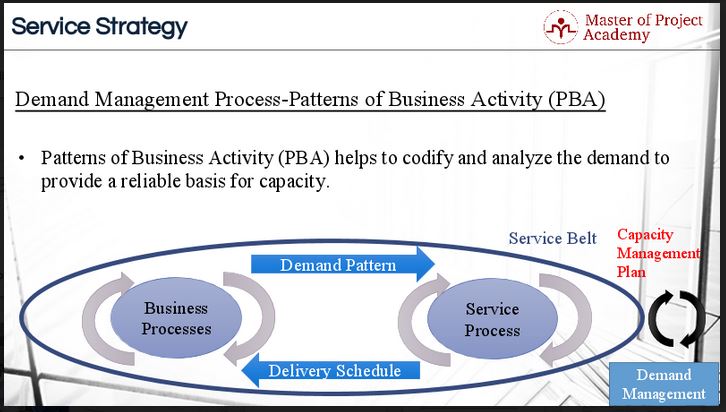What are demand management process and patterns of business activities? The careful planning of an IT service is crucial for the success of the service and the resulting value or revenue that it will generate for the organization. The outcome of the strategic planning phase affects all the other stages of the ITIL service lifecycle: ITIL Service Design, ITIL Service Transition, and finally ITIL Service Operation. There can be no planning of an IT service delivery without understanding the anticipated demand for such services. The demand management process is a critical part of the ITIL Service Strategy stage that takes place in parallel with the alignment of IT and business strategic objectives. Patterns of business activity (PBA) is an important part of the demand management process. It helps to codify and analyze the demand to provide a reliable basis for capacity. PBA analysis requires careful study of the customers’ business to truly understand the customer demand cycle. ITIL training details how PBA forms part of the demand management process.
In this article, we are going to discuss what Demand Management Process is and which PBAs are done during the ITIL Demand Management Process.

Here is how ITIL training on the demand management process balances the PBA concept
Online ITIL courses outline that business processes of an organization drive and determine the required services that need to be developed. Therefore, there is a demand for service processes. Required services are produced to satisfy demand coming from the business processes. Produced services are delivered to supply demand required by the business processes. And this figure where business processes generate demand and service processes delivers the required services to satisfy the demand is called the Service belt. In order to satisfy the demand required by the business processes, the capacity management plan is produced in accordance with the ITIL demand management process. This is the overall picture of patterns of business activity.

Demand Management Process: Managing PBA
During the demand management process, patterns of business activities are determined for multiple business activities as well as for multiple users. Different aspects of Demand Management Process need to be taken into account when planning for business activities compared to planning for users.
Managing PBA for multiple business activities
A pattern of business activity is actually a utilization profile of one or more business activities. PBA defines attributes of an activity such as frequency, volume and allowed delay variation. Let’s draw a sample PBA for some activities in the business processes. As you will see in the table, there are three activities and their frequency, volume and allowed delay attributes respectively.
- The first activity which requires a Demand management process is user login and this happens so frequently, its volume and allowed delay level is medium.
- The second activity which requires a Demand management process is customer data backup and happens in medium level frequency. Its volume and allowed delay attributes are high.
- The third and last activity in this PBA table which requires a Demand management process is Securing Customer Confidential Data. This activity happens rarely in the organization and its volume and allowed delay attributes are medium and low level respectively.

Managing PBA for multiple users in demand management process
A user profile is a pattern describing the user demand for IT Services. Every user has different needs and in their expectation from a service provider is different as well. This differs the user demand for services for different user profiles, therefore the demand management process. And every user profile includes one or more pattern of business activities. User profile and pattern of business activities are helpful to understand the demand of the customer and to channel it. This is how the demand management process is executed for managing PBA for multiple users.
For instance, this is an example of a user profile’s PBA matching. Imagine user profiles for a manager and an engineer. Each user profile has a different set of pattern of business activities. For example, while the manager frequently travels, the engineer rarely travels. Therefore the manager profile will need more mobile services compared to the engineer profile. Also when a manager requires technical assistance he needs to be supported immediately while an engineer’s request has more room for latency. These patterns of business activities and their mapping with the user profiles help us to determine demand of customer and how to prioritize this demand to give best service experience to the customers.
Demand Management Process: Interaction of PBA with Other Business Processes

The role of PBA in service portfolio management
The pattern of business activity analysis delivers important information for the service portfolio and other phases of the lifecycle. Service portfolio management is able to approve investment in additional capacities, new services or service changes. Based on the evaluation of capacity, new services might need to be developed or existing services might require improvements such as performance increase. In order to provide these additional capacity increases, development of new services, and changes in existing services, investments are approved in the service portfolio management process. During the ITIL Service Design phase, the service designs can be adjusted according to the pattern of business activities. Different business activities require different attributes such as frequency, volume and allow delay etc. Based on these various PBAs, services can be designed accordingly during the Service Design stage of the service lifecycle.
During the Service Design phase of the ITIL Process, the service designs can be adjusted according to the pattern of business activities. Different business activities require different attributes such as frequency, volume and allow delay etc. Based on these various PBAs, services can be designed accordingly during the Service Design stage of the service lifecycle.
The service catalog relates the pattern of business activities to the corresponding services. The service catalog includes all live services or services which are available for deployment in a service provider. All PBAs are interrelated with their corresponding services in the Service catalog.
Demand management process: PBA and the financial management process
Financial management can approve appropriate incentives in order to channel the demand. If there is a higher demand than expected, new investments should be done to increase capacity to supply the exceeding demand. At this point, financial management evaluates the investment alternatives and approves incentives in order to supply the required demand by the customers and the business.
The demand management process is an important part of the ITIL service lifecycle, specifically in the Service strategy stage. In the Service Strategy stage, the IT services for the business planning year are determined and the demand planning process is crucial to ensure that there will neither be inadequate capacity (resulting in poor service) or immoderate capacity (resulting in low value). In order to prevent these kinds of issues during the ITIL Processes, a comprehensive demand management process is really valuable.
